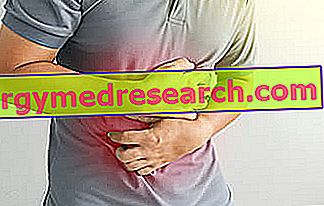Generality
In some women, ovulation is accompanied by the appearance of mild abdominal or pelvic pain, called " mittelschmerz ", a medical term meaning "pain in the middle of the cycle".

In a normal 28-day menstrual cycle, ovulatory pain occurs approximately 2 weeks after the onset of menstruation and coincides with the rupture of the mature ovarian follicle and the subsequent release of the egg cell. The disorder is typically unilateral, located in the lower abdomen on the right or left side, depending on which ovary is releasing an egg cell. The pain associated with ovulation can vary from a slight pain in the side to a serious discomfort; the duration extends from a few minutes to a few hours, but sometimes it can persist for a day or two. In some cases, slight bleeding may occur along with symptoms.
The discomfort associated with the mittelschmerz represents a common and harmless manifestation; in most cases, painful ovulation does not require medical attention. However, very intense pain can be symptomatic of other medical conditions, including endometriosis. For minor discomforts that can occur, painkillers and some home remedies are often effective. If the pain during ovulation is particularly annoying, the doctor may prescribe an oral contraceptive.
Symptoms
Ovulation occurs approximately 14 days before the next menstruation, hence the term mittelschmerz, which derives from the German words "medium" and "pain". We recall, in this regard, that the phase of variable duration is above all the first of the menstrual cycle, while the second (from ovulation to the beginning of menstruation) is rather constant.
Some women have a constant painful ovulation (every month), while others only occasionally. Painful manifestations differ from menstrual cramps and it is easy to distinguish them by a number of characteristic symptoms.
Mittelschmerz manifests itself with the appearance of pain in the lower abdomen or pelvis, in a central or lateral position. The pain can be located on one side of the abdomen, to pass to the opposite part during the next cycle, or it can be felt by the same side for several months in succession; its location, in fact, depends on which ovary is releasing the egg cell. In this sense, it would be useful to keep a record of the menstrual cycles for several months, noting the period in which there are pains in the lower abdomen and their characteristics. The pain may appear suddenly and disappear within a few hours, although sometimes it can last a day or two. In some rare cases, the symptoms can last until the next cycle.
In the case of painful ovulation, the symptoms may vary from person to person: a generalized feeling of heaviness may be felt, a pressure or slight twinges lasting a few hours, or a sharp pain, with cramps of equal or greater intensity than those that you experience during the menstrual flow. Pain may be accompanied by mild bleeding (spotting) or vaginal discharge. Some women may also experience nausea. In most cases, the mittelschmerz does not require any medical intervention. However, it is advisable to contact a specialist if the pelvic pain becomes severe or if the symptoms are particularly intense and persistent, as some of these signs may also indicate more serious conditions, such as a pelvic inflammatory disease or an ectopic pregnancy.
Women may notice other physical symptoms during or near ovulation. The most common sign is the appearance of cervical mucus in the days preceding ovulation, which is essential for natural methods of recognizing fertility.
Other secondary symptoms are:
- Blood loss in the middle of the cycle (spotting), due to the sudden drop in estrogen that occurs immediately before ovulation.
- Just before ovulation, the vulva may swell, particularly at the side where ovulation will occur.
- One of the inguinal lymph nodes (on the side where ovulation occurs) can swell and take about the size of a pea.
Causes
Pain can occur before, during or after ovulation. The exact cause is unknown, but there are several plausible explanations for the onset of the disorder:
- Swelling of the follicles inside the ovaries : just before the actual ovulation, the growth of the mature follicle containing the egg cell dilates and extends the surface of the ovary, causing pain.
- Ovarian wall rupture : with ovulation, the oocyte is released from the follicle through the rupture of the ovary wall. For some women, this process can make ovulation painful.
- Abdominal irritation : when an egg cell develops in the ovaries, it is surrounded by follicular fluid. At the time of ovulation, at the rupture of the mature follicle containing the oocyte, the fluid, together with a slight amount of blood, is released from the ovaries and can irritate the lining of the abdominal cavity (peritoneum). This can trigger the pain that disappears once the liquid is absorbed.
- Contraction of smooth muscle cells : during ovulation, pain may be related to the contraction of smooth muscle cells in the ovary and its ligaments. These contractions occur in response to an increase in the level of prostaglandin F2-alpha and the wave of luteinizing hormone (LH).
- Fallopian tube contraction : after ovulation, the fallopian tubes can contract (similar to the peristalsis of the esophagus), causing pain in some women.
The pain that appears at any other time in the menstrual cycle does not correspond to the mittelschmerz. It can instead be traced to disorders associated with dysmenorrhea (example: menstrual cramps), if it occurs near menstruation, or may depend on other abdominal problems or in the pelvic region. If the pain is very intense during ovulation or at any other time in the cycle, it is advisable to consult a doctor.
Underlying health problems
Ovulation occurs about two weeks after the first day of each menstrual cycle, so the characteristic period in which pain arises makes the mittelschmerz easy to recognize. To help determine if the pain is associated with ovulation, the doctor may request the patient to track menstrual cycles, noting painful episodes and their location (ovulation pain usually occurs on one side of the lower abdomen). Your doctor may also perform a pelvic exam to help rule out other possible causes of pain, such as endometriosis or an ovarian cyst. If the pain is severe and there are some irregularities on the physical examination, further investigations could be indicated to determine the cause of pelvic or abdominal pain.
In most cases, the manifestations associated with ovulation are harmless and do not indicate the presence of a disease. However, severe and persistent pain localized in the lower abdomen or in the pelvic region may be a symptom of various medical conditions, including:
- Salpingitis - inflammatory process of the fallopian tubes following an infection.
- Pelvic inflammatory disease - represents the outcome of an infection, of which sexually transmitted pathogens (eg gonorrhea, chlamydia) or bacteria normally present in the vagina are often responsible. The symptoms of pelvic inflammatory disease include fever, lower abdominal pain and high concentration of white blood cells.
- Endometriosis - consists of the development of endometrial tissue outside the uterus, in an abnormal location. Abdominal pain, bleeding, compression on adjacent structures and infertility are the most common symptoms.
- Ovarian cyst - consists of an abnormal fluid collection, surrounded by a very thin wall, which develops inside an ovary. Symptoms may include bleeding and pain.
- Ectopic pregnancy - is defined when a pregnancy develops outside the uterus, most commonly in one of the fallopian tubes. Symptoms include cramps, abdominal pain and vaginal bleeding.
- Appendicitis - inflammation of the appendix; sometimes it can be confused with the pain associated with ovulation. Seek immediate medical assistance if the pain is intense and localized in the lower right part of the abdomen (it can be associated with loss of appetite, nausea or vomiting).
- Other gastrointestinal problems - pains in the lower abdomen can be symptomatic of a series of gastrointestinal problems, including perforated ulcer, gastroenteritis and inflammatory bowel disease.
Diagnosis
In most cases, it is not necessary to consult a doctor in case of painful ovulation. However, if the pain is particularly annoying, lasts more than three days or is associated with other unusual symptoms, it is possible to ensure - through some medical tests - that the disorder is not caused by other problems and, if so, to evaluate the treatment options .
The diagnosis of mittelschmerz is based on exclusion (ie the doctor must make sure that no other pathological conditions exist) and is generally confirmed if the analysis results are normal, the pelvic exam shows no abnormalities and if the patient is halfway through the cycle . If the pain is persistent and / or severe, other diagnostic procedures such as an abdominal ultrasound may be performed to rule out other causes of pelvic pain. Mittelschmerz's pain is sometimes confused with appendicitis and one of the differential diagnoses involves assessments for this condition (in women of childbearing age).
The tests that help determine if the pain associated with ovulation is harmless or caused by an infection or illness can include:
- Anamnesis (collection of information on symptoms reported by the patient, any health problems, medications and food supplements that you are taking etc.);
- Physical examination, including a pelvic exam;
- Blood tests;
- Cervical cultures;
- Abdominal ultrasound;
- Transvaginal pelvic ultrasound;
- Exploratory laparoscopic abdomen surgery.
If you experience any of the following symptoms during ovulation, it is advisable to consult a doctor:
- Temperature;
- Pain with urination;
- Redness or burning of the skin at the site of pain;
- He retched;
- Pelvic or abdominal pain that persists beyond 3 days;
- Other symptoms such as severe bleeding or vaginal discharge.
Treatment and Remedies
Ovulatory pain usually resolves spontaneously in about 24-48 hours, so no specific treatment is needed. If the pain associated with ovulation is constant, occurs every month and is particularly annoying, it is possible, on the advice of your doctor, to seek relief by taking the contraceptive pill or other forms of hormonal contraception. Oral contraceptives modify the female hormone cycle preventing ovulation, so they can be adopted to prevent ovulatory pain. In cases of prolonged or intense pain, it is possible to use painkillers, such as naproxen, paracetamol or ibuprofen, generally effective in alleviating the discomfort associated with painful ovulation.
Moreover, some simple remedies allow you to get relief from the symptoms; these include the application of a hot water bottle on the side of the abdomen where pain occurs, or taking a bath to help alleviate discomfort: heat increases blood flow, relaxes tense muscles and relieves the cramps. During ovulation, it may be useful to avoid foods made from yeast and dairy products.
To remember
- About one in five women experience pain during ovulation, which can last from a few minutes to 48 hours.
- Pelvic or abdominal pain that occurs halfway through the cycle is usually harmless, but can sometimes indicate an underlying pathology, such as endometriosis.
- Consult your doctor if ovulatory pain persists for more than three days or is associated with other unusual menstrual symptoms, such as severe bleeding.
- Mittelschmerz can be painful, but it is not a sign of illness. In fact, some women experience painful ovulation as an advantage to plan or try to avoid pregnancy.



